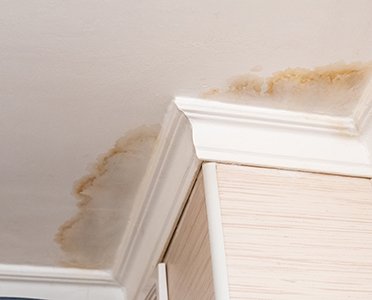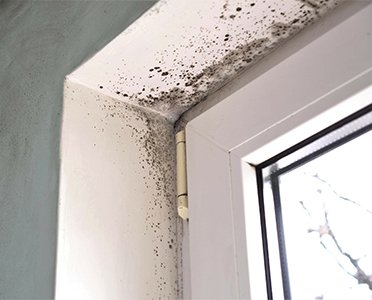Damp, mould and condensation
The Regulator of Social Housing has served a notice to Kirklees Council stating that we need to make improvements to our standards on fire safety, damp, mould, and condensation.
More information: Regulation Notice - Fire safety, damp, mould and condensation
Please report all cases of damp, mould and condensation to us and contact us if you have any concerns or need assistance.
- Email dmc@kirklees.gov.uk
- Phone 01484 414800
You can also request damp, mould and condensation, and all other repairs at Report a repair .
Damp
Damp can cause mould on walls, furniture and clothing. Damp can be caused by:
- Leaking or cracked pipes or overflows
- No damp coursing in a house or faulty damp coursing
- Rain leaking through a roof, faulty window or door frames
- Overflowing water from a bath.
These causes of damp often leave a 'tidemark'
Report a repair if you think you may have damp in your property due to one of the above, and we can visit you to check and help resolve the issue.
If you don't think damp in your home is caused by any of the above, it may be that any damp you are experiencing could be due to condensation.


Condensation
Condensation is caused by moisture in the air. There is always moisture in the air, even if you can't see it. When the air gets colder, it cannot hold a lot of moisture, so droplets of water may appear near windows or doors, in the corner of rooms, behind cupboards or wardrobes, or on other cold surfaces and in places where there is little movement of air. It mainly occurs during cold weather.


There are several things you can do to prevent this. Here are some tips:
Some ordinary daily activities produce a lot of moisture very quickly:
- Dry-washing outdoors or in the bathroom with the door closed and the window open or the fan on
- Vent any tumble dryer on the outside, unless it is a self-condensing kind. You can get cheap DIY kits for this.
- Do not leave kettles boiling and cover all pans
- Avoid using paraffin and portable, flueless bottled gas heaters as these put a lot of moisture into the air
You can ventilate your home without making a draught:
- If fans are installed, please ensure that you use them at all times
- Ventilate kitchens and bathrooms when in use by opening the windows wider
- Keep a small window ajar or a trickle ventilator open when someone is in the room
- Close the kitchen and bathroom doors when these rooms are in use - even if they have an extractor fan this will help prevent moisture reaching other rooms
- Don't put too many things in cupboards and wardrobes as this stops air circulating
- Cut 'breather' holes in doors and in the back of wardrobes and leave space between the back of the wardrobe and the wall
- Position wardrobes and furniture against internal walls where possible
Insulation and draught-proofing will help keep your home warm and cut fuel bills. When the whole home is warmer, condensation is less likely.
- Ensure that you know how to operate your heating effectively and ask us if you are unsure
- In very cold weather, keep low background heating on all day, even when there is no one at home
- In your loft, check that you have sufficient insulation. If you feel that the insulation is not sufficient then please Report a repair to arrange for an insulation survey
- During winter nights close your curtains to keep the heat in.
Find out more information about keeping your house warm and reducing energy bills.
In your home:
- In colder weather try and keep temperatures above 17℃ in main living areas whilst indoors
- Don't block airbricks or air vents
- To kill and remove mould, wipe down walls and window frames with a fungicidal wash which carries a Health and Safety Executive approval number
- Dry washing outside where possible
- Don't dry clothes on radiators. This will make your boiler work harder to heat your house and cost almost as much as using a tumble dryer, whilst creating a lot of condensation.
- If you have to dry clothing indoors, and don't have a tumble dryer, place clothes on a drying rack in a sunny room where a window can be opened slightly and keep the door closed
- No drying rack? Put your clothes on hangers and hang them from a curtain pole above a slightly opened window; this can also reduce the need for ironing.
In your living room:
- Open window trickle vents during the day or when going out, or open windows for at least 10 minutes every day
- Lay thick carpet with a good thermal underlay
- Hang thick, heavy-lined curtains during the winter
In your kitchen:
- Close internal doors whilst cooking and open window(s)
- Use an extractor fan if you have one
- Put lids on pans (this also reduces boiling times and helps save money)
- Only boil as much water as you need in a kettle to reduce steam and save money
In your bathroom:
- Open windows whilst bathing/washing and leave them open for about 20 minutes after, if it's safe to do so
- Use an extractor fan if you have one
- Take shorter and cooler showers
- When running a bath, put the cold water in first; this results in significantly less condensation
- Wipe down windows/mirrors/tiles/shower doors with a window squeegee and mop up the moisture with a super absorbent cloth which can be wrung out in the sink
- Don't leave wet towels lying around
- Try drying yourself with a smaller towel and wringing it out, wrapping yourself in a bigger towel or dressing gown for warmth
- Microfiber towels are great for this as they absorb more water and dry quickly
In your bedroom:
- Wipe down windows with a window squeegee
- Open window trickle vents during the day or when going out, or open windows for at least 10 minutes every day
- Don't put furniture, including beds, against any outside walls and try and leave a gap between the wall and furniture to allow airflow
- Lay thick carpet with a good thermal underlay if you can
- Hang thick, heavy-lined curtains during the winter
If decorating:
- When wallpapering, use a paste containing a fungicide to prevent further mould growth
- Use thermal lining paper under wallpaper when decorating
- Use mould-resistant paint on areas prone to mould, such as ceilings above windows.
Mould
If you discover mould due to condensation in your home, treat it as soon as possible. If you ventilate and insulate your home correctly, mould shouldn't appear. If it does:
- wipe down walls and window frames with a fungicidal wash which carries a Health and Safety Executive approval number. Make sure you follow the manufacturer's instructions precisely
- dry-clean mildewed clothes and shampoo carpets - disturbing mould by brushing or vacuum cleaning can increase the risk of respiratory problems.
After treatment, redecorate using good quality fungicidal paint to help prevent mould from recurring.
Black mould can't grow where salt deposits are present (as with rising damp) and therefore mould is a sign of condensation.
If you're unsure how to spot, prevent or remove mould, damp or condensation - please give us a ring so we can advise.
If you're struggling to heat your home, we and our partners can help with financial advice and support.